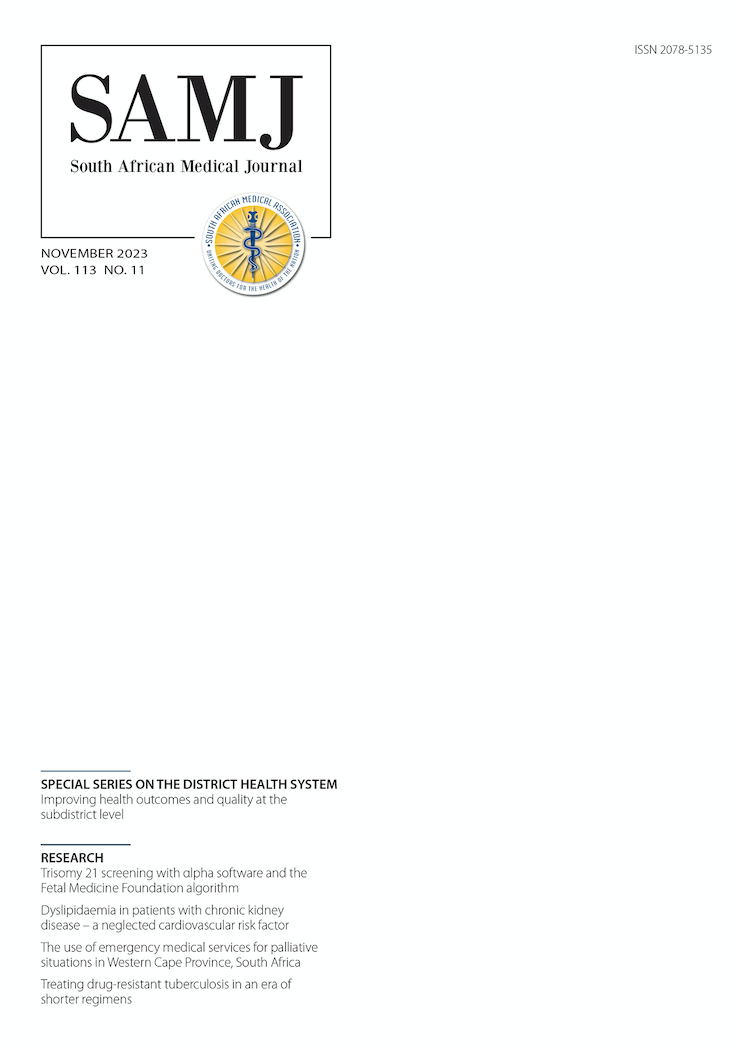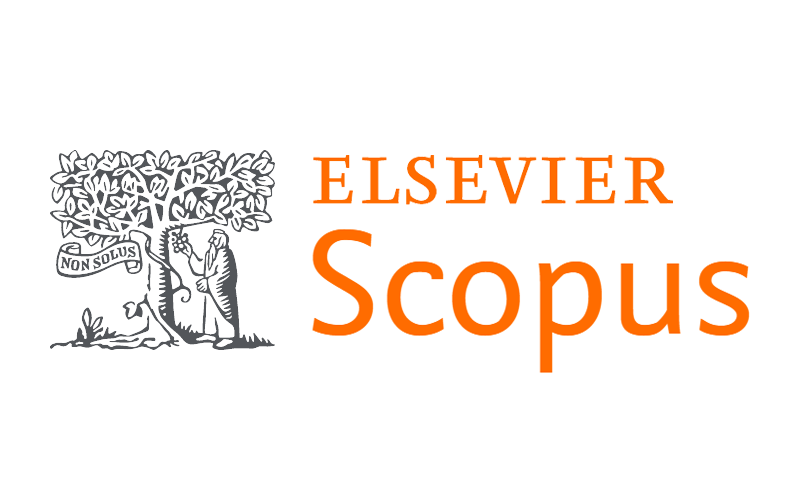Trisomy 21 screening with αlpha software and the Fetal Medicine Foundation algorithm
DOI:
https://doi.org/10.7196/SAMJ.2023.v113i11.885Keywords:
screening, Down syndrome, alpha software, Fetal Medicine Foundation, fetal, ultrasoundAbstract
Background. Screening for trisomy 21 provides pregnant women with accurate risk information. Different algorithms are used to screen for trisomy 21 in South Africa (SA). The Fetal Medicine Foundation (FMF) provides software to screen for trisomy 21 in the first trimester by ultrasound or a combination of ultrasound and biochemistry (combined screening), and requires regular and stringent quality control. With αlpha software, first trimester combined screening and screening with biochemistry alone in the first or second trimester are possible. The αlpha screening requires quality control of biochemical tests, but not of ultrasound measurements. Ideally, a screening test should have a high detection and a low screen positive rate. Despite the availability of these screening programmes, only a minority of infants with trisomy 21 are detected prenatally, raising questions about the effectiveness of screening.
Objectives. To determine the screen positive and detection rates of prenatal screening for trisomy 21 in the SA private healthcare system. Methods. Data from the three largest laboratories collected between 2010 and 2015 were linked with genetic tests to assess screen positive and detection rates. Biochemical screening alone with αlpha software (first or second trimester) and combined screening using either FMF or αlpha software were compared.
Results. One-third of an estimated 675 000 pregnancies in private practice in the 6-year study period underwent screening. There were 687 cases of trisomy 21 in 225 021 pregnancies, with only 239 (35%) diagnosed prenatally. The screen positive rates were 11.8% for first trimester biochemistry, 7.6% for second trimester biochemistry, 7.3% for first trimester FMF software ultrasound alone, 3.7% for combined first trimester screening with FMF software, and 3.5% for combined first trimester screening with αlpha software. The detection rates for a 5% false positive rate were 63% for first trimester biochemistry, 69% for second trimester biochemistry, 95% for combined first trimester screening with FMF software and 80% for combined first trimester screening with αlpha software. Detection and confirmation rates were highest with FMF software.
Conclusion. Screening with FMF software has a similar screen positive rate and better detection rate than screening with αlpha software. The low prenatal detection rate of trisomy 21 is mainly due to a low prevalence of screening. More research is needed in the SA setting to explore why screening and confirmatory testing after high-risk results are not performed in many pregnancies.
References
Hui L. Noninvasive approaches to prenatal diagnosis: Historical perspective and future directions.
Methods Mol Biol 2019;1885:45-58. https://doi.org/10.1007/978-1-4939-8889-1_3
Cuckle H, Maymon R. Development of prenatal screening – a historical overview. Semin Perinatol
;40(1):12-22. https://doi.org/10.1053/J.SEMPERI.2015.11.003
Minear MA, Lewis C, Pradhan S, Chandrasekharan S. Global perspectives on clinical adoption of
NIPT. Prenat Diagn 2015;35(10):959. https://doi.org/10.1002/PD.4637
Geerts L. Prenatal diagnosis of chromosomal abnormalities in a resource-poor setting. Int J Gynecol
Obstet 2008;103(1):16-21. https://doi.org/10.1016/J.IJGO.2008.05.028
Bhorat I, Chauke L, Coetzee E, et al. Challenges and controversies in prenatal genetic screening in
the South African context. Obstet Gynaecol Forum 2018;28(1):33-36. https://doi.org/10.10520/EJCcebec9ee9
Urban M, Geerts L. Prenatal diagnostic services and prevention of birth defects in South Africa.
In: Kumar D, ed. Genomics and Health in the Developing World. Oxford: Oxford University Press,
:547-567.
Nicolaides KH. Screening for fetal aneuploidies at 11 to 13 weeks. Prenat Diagn 2011;31(1):7-15.
https://doi.org/10.1002/pd.2637
Wald NJ, Radeck C, Hackshaw AK, et al. First and second trimester antenatal screening for Down’s
syndrome: The results of the Serum, Urine and Ultrasound Screening Study (SURUSS). J Med Screen
;10(2):56-104. https://doi.org/10.1258/096914103321824133
Wright D, Kagan KO, Molina FS, Gazzoni A, Nicolaides KH. A mixture model of nuchal translucency
thickness in screening for chromosomal defects. Ultrasound Obstet Gynecol 2008;31(4):376-383.
https://doi.org/10.1002/UOG.5299
Cuckle H. Monitoring quality control of nuchal translucency. Clin Lab Med 2010;30(3):593-604.
Downloads
Published
Issue
Section
License
Copyright (c) 2023 L Pistorius, C A Cluver, I Bhorat, L Geerts

This work is licensed under a Creative Commons Attribution-NonCommercial 4.0 International License.
Licensing Information
The SAMJ is published under an Attribution-Non Commercial International Creative Commons Attribution (CC-BY-NC 4.0) License. Under this license, authors agree to make articles available to users, without permission or fees, for any lawful, non-commercial purpose. Users may read, copy, or re-use published content as long as the author and original place of publication are properly cited.
Exceptions to this license model is allowed for UKRI and research funded by organisations requiring that research be published open-access without embargo, under a CC-BY licence. As per the journals archiving policy, authors are permitted to self-archive the author-accepted manuscript (AAM) in a repository.
Publishing Rights
Authors grant the Publisher the exclusive right to publish, display, reproduce and/or distribute the Work in print and electronic format and in any medium known or hereafter developed, including for commercial use. The Author also agrees that the Publisher may retain in print or electronic format more than one copy of the Work for the purpose of preservation, security and back-up.





